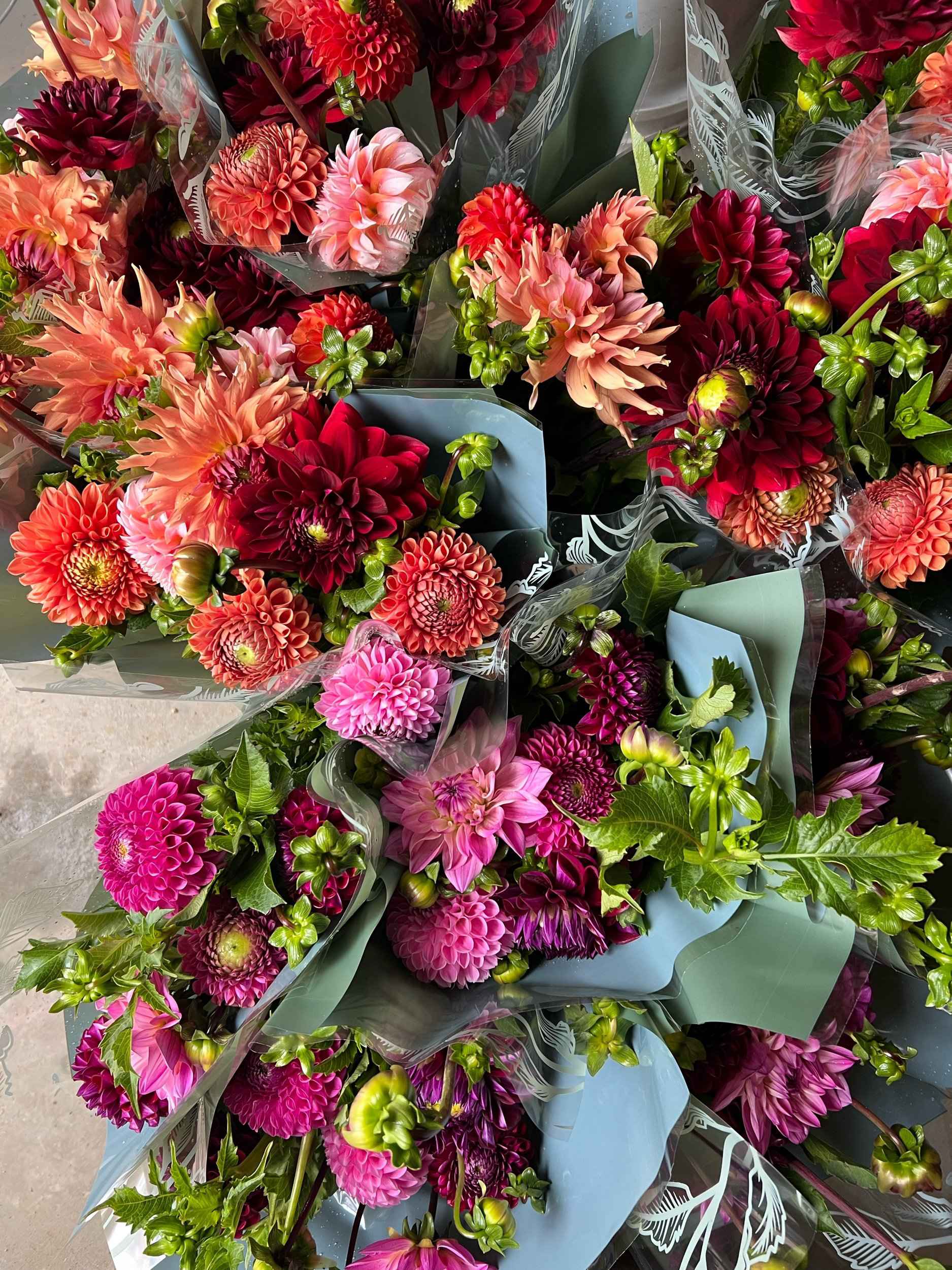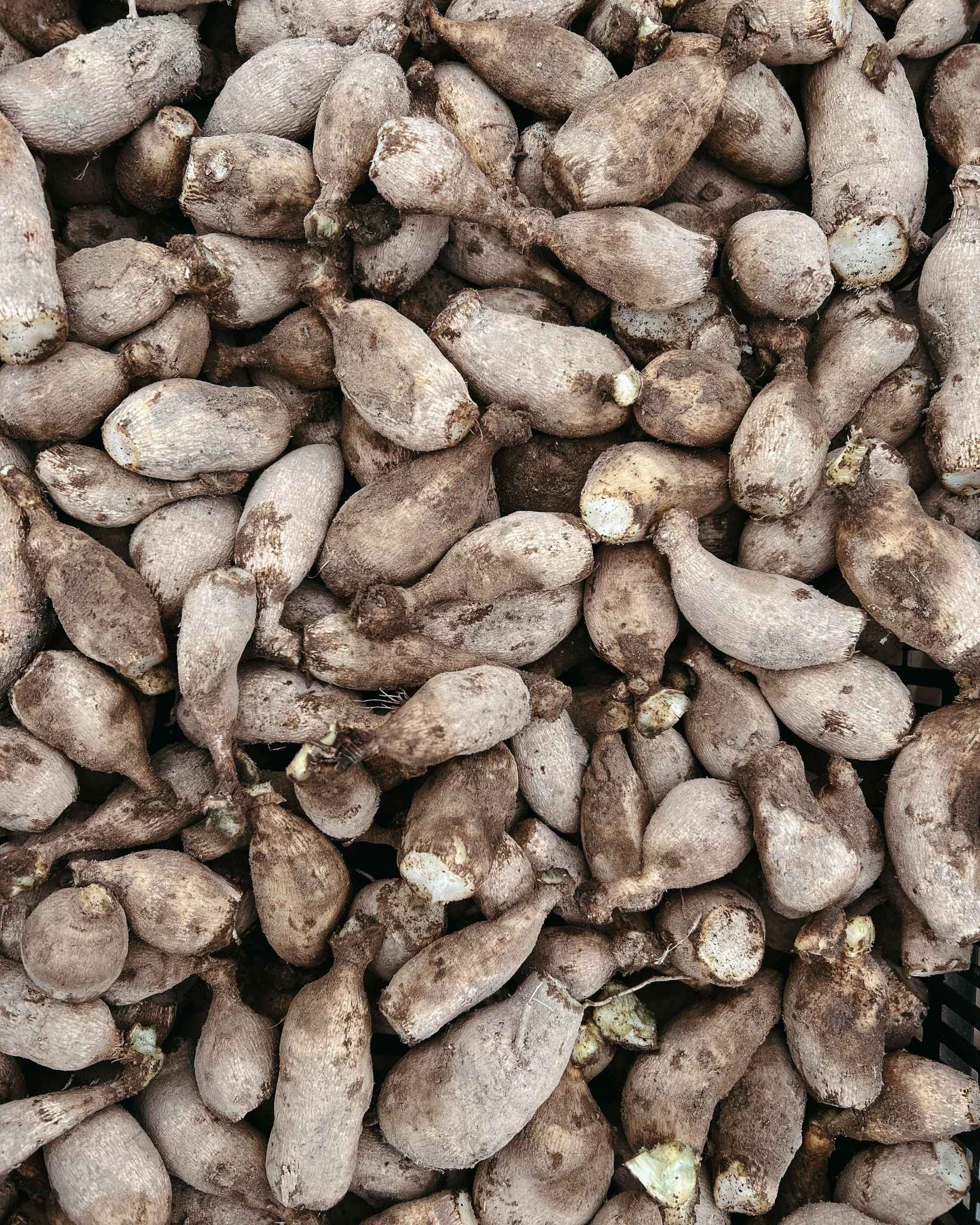Planting 101
Temperature: Do not plant dahlia tubers until all danger of freeze/frost has passed, and soil temperature is consistently 60 degrees.
Storage: Tubers from Russells Mills Flower Co can be stored in their packages, in a cool dark place until you’re ready to plant. Inside the bags is organic peat moss which can be discarded or incorporated at planting.
Placement: Dahlias thrive in full sun. Plant tubers 6” deep and 12” apart.
Water: Do not water tubers until they’ve sprouted through the soil, doing so will cause them to rot.
Support: Some dahlias do need support due to their height. If you’re planting a large amount of dahlias— try growing them in a hedge and applying a horizontal netting. If you only have a few plants— provide support by tying them to wooden stakes, bamboo poles or using tomato cages.
Pinching: Pinching dahlias will give them a stronger base. It is recommended but not required! The best time to pinch dahlias is when they have 4 sets of leaves or around 10” tall. By removing the center growing point the plant puts energy into the lateral growth creating a sturdier base. Pinching dahlias will delay blooms by a few weeks. If you don’t pinch your dahlias, keep in mind when you harvest your first flower to cut deeply into the plant (that is essentially your “pinch”)
Fertilizer: We find dahlias benefit highly from fertilizer (ie: well composted manure, foliar feeds, fertigation, slow/control release fertilizer). For optimal soil health submit a soil sample for a complete nutrient analysis and fertilizer recommendation. This can be done with the help of your local ag extension.
Irrigation: Irrigate dahlias deeply on a regular schedule. Although dahlias love water they don’t like frequent shallow waterings which keeps them soggy.
Weeds & Pests
Common Pests: Japanese beetles, thrips, aphids, slugs, leafhoppers.
Tip: Use your local ag extension for guidance on how to manage pests in your area.
Common Weed Management Practices: Cultivation, weed barrier (plastic or paper barrier to block sun from weeds growing), or mulching (using decomposed plant material to block weeds).

Harvesting Flowers
Time of Day: The best time to harvest flowers is early in the morning or late in the evening. Mid-day flowers are least hydrated from the high sun.
Tools: Use a sharp and sanitized tool to cut deeply above a leaf node with a long enough stem for bouquets. Strip leaves and place cut flowers directly into water and let rest for best hydration and vase life. For the longest vase life, replace water frequently, remove any foliage that sits below the water line, do not place near fruit or vegetables and keep away from direct sunlight.
Dahlias are not known for their vase life but their fleeting beauty is all part of their allure! Ball type and decorative type dahlias will last the longest in a vase while dinner plate, anemone or collarette types have a shorter vase life.
Harvesting Tubers
Unearth dahlia clumps starting 1’ away from the stalk as to not injure the tubers underground. We
recommend using a potato fork or pitchfork. Fully encompass the tubers and gently lift the clump.
Although damaged tubers are more susceptible to decay, piercing a tuber with a tool won’t kill it if it has 3 essentials: an eye, a neck, and a tuber.
In zones 7 and lower (where winter reaches 20 degrees and colder) your dahlias will be killed by a frost. Once a dahlia receives frost the plant will become blackened— be sure to tag your plants before frost for future identification! Leaving the plants in the ground for at least one week after frost before digging will toughen the skin and aid in their ability to store over winter.
Beware: Rain can collect in the stalk of the dahlia and cause rot so wait to cut back plants until you’re ready to dig or there is a clear forecast. Be sure to cull any plants that seem unhealthy so you keep the best and strongest plants for your future gardens.
Note: If you live in zone 8-10, tubers can be kept in the ground. Dividing every (3) years is best for keeping happy and healthy dahlias.

Dividing Tubers
Tubers can be divided at any time once dug. Tuber eyes can be seen easier immediately after being dug or closer to planting time when tubers are “waking up” for planting time.
Tubers need 3 things: an eye (where new growth is formed), enough starchy material to provide the tuber food to grow roots (tuber), and a “neck” to connect the two.
Tubers come in all shapes and sizes - just like us! Some form eyes sooner or later than others, have fragile skin, or even store better than others.
The size of a tuber does not indicate whether a plant will be bigger or smaller, or produce more flowers.
It can take some practice to get comfortable at diving tubers successfully. To be on the safe side you can divide dahlia clumps into quarters or in half. To help find dahlia tuber eyes you can use a marker to circle where you think you see an eye and watch to see if growth continues in that area.
Storing Tubers
The easiest way to pick which storage method would work for your tubers is starting with where you will be storing them. Tubers want be cool (40-50*) and humid (60-70%). However you can best recreate that scenario is what’s best for you. Most gardeners find great success with a basement or an insulated garage. You can use a variety of containers: wash bushel boxes, wooden crates, plastic bins, cardboard boxes. You can also use a variety of insulating materials: peat moss, vermiculite, wood shavings.
The goal is to retain enough moisture to keep the tubers from shriveling or drying out while also keeping them cool but not too cold. Do not let tubers freeze - frozen tubers turn to mush! Check on your dahlias periodically in storage. If tubers are too moist you can increase ventilation and if they’re too dry or shriveling you can try misting/dampening your growing media.


